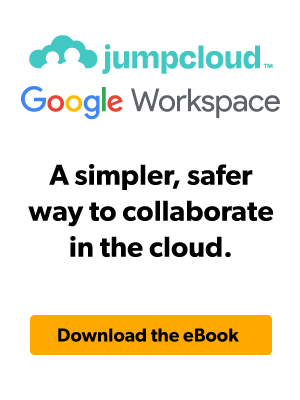In today’s fast-paced digital era, effective collaboration and seamless communication are paramount for businesses and teams of all sizes.
To meet these demands, Google Workspace has emerged as an all-encompassing productivity suite, empowering organizations with a comprehensive set of tools to streamline workflow and enhance teamwork. At the core of this suite lies the Google Workspace Directory, which manages users, groups, and shared resources.
In this blog post, we’ll explain Google Workspace Directory’s key features and use cases. Then, we’ll show you how combining Google Workspace Directory with JumpCloud creates a full-scale directory solution that combines identity, access, and device management with a modern productivity solution.
What is Google Workspace Directory?
Google Workspace Directory (formerly known as Google Apps Directory) is a feature within the Google Workspace productivity suite that serves as a centralized repository and management system for user accounts, groups, and shared resources. It allows admins to create and manage user accounts, granting or revoking access to specific applications and services based on individual roles and permissions.
The Google Workspace directory is designed to be the user management system for Google Workspace, as well as enable web application single sign-on through a variety of protocols, including SAML, OAuth, and OpenID Connect. Ultimately, Google’s goal is to enable you to use more Google services through one Google identity. Google also wants to make it easy to use a Google Workspace identity to log into other web applications.
In addition to user management, the Google Workspace Directory enables the creation and management of groups. Groups can be used to facilitate communication and collaboration within an organization. By grouping users together, administrators can easily manage access permissions, sharing settings, and communication preferences for a specific set of individuals. This simplifies the process of sharing documents, calendars, and other resources, as well as enables efficient communication through group emails and shared mailing lists.
Google Workspace Directory Features and Use Cases
The Google Workspace Directory offers features that empower organizations to effectively manage users, groups, and resources within the Google Workspace environment.
- User Management: Create, manage, and deactivate Google Workspace user accounts, onboard and offboard employees, assign specific roles and permissions, and control access to various Google Workspace services.
- Group Management: Create and manage groups organized by teams, departments, or project-specific collaborations.
- Access Controls: Define specific permissions for individual users or groups so each user has access to the tools and resources they need while maintaining data security and privacy.
- Security and Authentication: Enforce strong password policies, enable multi-factor authentication, and implement device management controls to enhance the security of user accounts and prevent unauthorized access.
By leveraging these key features, organizations can streamline user management, improve collaboration, enforce security measures, and create a unified and productive digital workspace for their teams.
Benefits of Google Workspace Directory + JumpCloud
While Google Workspace Directory works seamlessly within the workspace suite, it’s important to note that it was designed – and works for – a very specific use case: Google applications. It does not have the same functionalities outside of the Google environment. For that, you need to partner Google Workspace Directory with an agnostic open directory platform like JumpCloud.
- Access Everything: Extend Google Workspace with unified device and access management, giving users one identity for everything they need, no matter where they are.
- Streamline Onboarding and Offboarding: Automate user lifecycle workflows, allowing you to rapidly provision and manage users across applications, devices, and networks.
- Simplify Zero Trust Security: Seamlessly grant users access to all the resources they need and nothing they don’t, using their Google Workspace identity on a secure device of their choice.
- Connect – Anywhere, Anytime: Connect to any resource from any location using a trusted device, with one secure identity in the cloud.
- Cut Complexity and Costs: Unify identity, access, and cross-OS device management, in a cost-effective manner that doesn’t sacrifice security or functionality and avoids vendor lock-in.
- Save Time: Get complete visibility into user access and device posture, saving time from troubleshooting, audits, and compliance.
Combining these two platforms creates a powerful full-scale unified directory service that marries identity, access and device management with top-of-the-line productivity solutions. With Google Workspace Directory + JumpCloud, you can extend your Google identities to other non-Google resources, giving your IT admins a centralized and comprehensive management solution in a single pane of glass.
See What’s Possible with JumpCloud + Google Workspace
Using the JumpCloud Directory Platform and Google Workspace together provides a cost-effective, best-in-class alternative to legacy single-vendor solutions that’s easier than ever to implement and roll out. It combines the benefits of Google’s productivity solution with a cloud-based open directory platform to form a modern collaboration and identity, access, and device management solution, one that eliminates the need for many point solutions that bog down IT environments. Learn more about the partnership between JumpCloud and Google Workspace.





